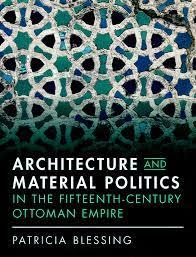Patricia Blessing *12 Unpacks Architecture in the Ottoman Empire
The book: In her latest book, Blessing explores the emergence of Ottoman architecture in the 15th century. Through her analysis of the ways transregional exchange shaped building practices, Blessing transforms our understanding of the design, planning, and construction processes of a major empire. She examines how workers from Anatolia, the Mediterranean, the Balkan, and Iran and Central Asia participated in key construction projects during this time period. Architecture and Material Politics in the Fifteenth-century Ottoman Empire (Cambridge University Press) includes detailed analysis of buildings, building inscriptions, and poetry to highlight the ways text and architecture were intertwined.

The author: Patricia Blessing *12 earned her Ph.D from the University in art and archaeology. She joined Princeton’s faculty in 2020, and specializes in the art and architecture of the Islamic world, with a focus on the eastern Mediterranean from the 12th to 15th centuries. She’s the author of a number of books including Rebuilding Anatolia after the Mongol Conquest.
Excerpt:
Introduction
The buildings designed and built by the architect sinan (d. 1588) in the imperial capital Istanbul, with their stripped-down aesthetic of impressive volumes and monumental domes, have become the epitome of Ottoman architecture. Active from the 1530s until the 1580s, Sinan designed monuments at both the large scale required by the sultans and the smaller one accorded to viziers, admirals, and princesses, as seen in the mosques built for Sultan Süleyman the Magnificent in 1550–77 and for one of his grand viziers, Rüstem Pasha, in 1563. Sinan’s work and the work of the office of imperial architects (hassa mimarları) define our understanding of architecture in the Ottoman Empire from the sixteenth century onward, and they were integral parts of the functioning of a centralized empire that tightly regulated its administration and its aesthetic outlook.1 But while these developments are well known, less understood is what happened in the first half of the fifteenth century, when what we now think of as classical Ottoman architecture began to coalesce. The transformation of Byzantine Constantinople into the Ottoman capital over the course of the second half of the fifteenth century under the patronage of Mehmed II has been examined in detail due to its crucial importance and the scale of the project, yet it has largely been analyzed in isolation from the broader context of architecture across the empire. Moreover, equally important is the earlier part of the fifteenth century, when a visual identity was being actively shaped in a cultural and political context that was fluid and malleable enough to draw from an extremely varied array of sources and influences.
In this book, I analyze the fifteenth century on its own terms rather than looking backward from the vantage point of the unified imperial architecture of the mid-sixteenth century. As we shall see, Ottoman art and architecture of the fifteenth century stand at multiple crossroads: between Renaissance Italy and Timurid Central Asia, between Anatolia and the Balkans, and between Byzantine and Islamic architectural styles. In this fluctuating world, patrons, artists, and architects explored diverse modes of representation that eventually converged into a distinctly Ottoman aesthetic during the reign of Bayezid II (r. 1481–1512). The question is not one of origin – Eastern or Western, local or foreign – but one of how seemingly disparate elements of architecture were combined. Over time, an imperial Ottoman style came to be consolidated in connection to the larger epistemological project of the late fifteenth and early sixteenth centuries, when knowledge was methodically organized and cataloged. The study here includes Ottoman monuments built both before and after the Ottoman conquest of Constantinople, to allow us to consider long-term developments that shed light on the wide range of architectural practice within the nascent empire. Such an approach also connects the dots back to studies that focus on Ottoman architecture built in the fourteenth century, and to the question of Ottoman emergence. Chronologically, therefore, this book extends from the early fifteenth to the early sixteenth century, with forays into late fourteenth-century Ottoman and beylik (the Muslim-ruled principalities of Anatolia) architecture.
The choices made by the actors involved in these projects as they commissioned, designed, and built monuments form the core of the concept that I define as material politics. This concept includes, on the one hand, the politics of patronage – who commissions what, when, and where – that reflect the shifting power structures in the fifteenth-century Ottoman Empire. On the other hand, it also addresses the material preferences that are made on and for building sites – that is, the politics of stylistic choices, which come into play in the use of design models adapted from paper, and the hiring of workers with a wide variety of backgrounds, who then contributed to the formation of Ottoman identity through architecture.
Crucially, identity formation within the Ottoman Empire was closely intertwined with the multilingual and multireligious environment of the Balkans and Anatolia. The actors who were part of the fifteenth-century Ottoman landscape embodied the concept of Rumness coined by Cemal Kafadar. ı Seemingly disparate elements blended with ease in Rumness and Ottoman Turkish emerged as its literary expression, but without ethnic identity being fixed, in contrast to what twentieth-century nationalist historiographies state. The Rum identity was most fundamentally based on close ties to the geography of the Lands of Rum. In the Ottoman imaginary until the mid-eighteenth century, Rum extended beyond the confines of the defunct eastern Roman Empire, from which the term derived, to include both the Ottoman Balkans (Rumili, Rumelia) and Anatolia up to but not south of the Taurus Mountains.
Definitions associating Anatolia with the territory of the Republic of Turkey and with Turkish ethnic identity emerged in the early twentieth century, in close parallel to the establishment of a nation-state in 1923. In history writing, M. Fuad Köprülü (1890–1966) was a central figure in the 1930s and 1940s for his work on the emergence of the Ottoman enterprise and on medieval Anatolia as a place where Turkish Islamic culture, including its literary and religious expressions, developed. Köprülü pushed back against Western notions that presented the Ottoman Empire as a simple copy of the Byzantine Empire, which made no cultural contribution. From the 1930s onward, cultural unity under the umbrella of Anadoluculuk (Anatolianism) was claimed as part of the Turkish nation-state’s identity, with significant impact on the study of art history and archaeology, as Scott Redford explains. Importantly, Anatolianism did not emphasize Islam as a unifying feature, but rather claimed that Anatolia had been a coherent political and cultural space since the Hittite period in the second millennium BCE. Beginning in the 1950s, historians of medieval Anatolia such as Osman Turan (1914–78) and Ibrahim Kafesoğlu (1914–84) shifted to an approach that emphasized the emergence of a specifically Turkish and Muslim culture in Anatolia with the rule of the Saljuqs (Türk-İslam sentezi), starting in the late eleventh century. Further, the notion of a Saljuq–beylik–Ottoman sequence was adopted for the study of the region, as Oya Pancaroğlu notes, erasing complex historical and cultural dynamics. The Turkish Islamic culture proposed by Turan and others for the medieval period was correlated with the territories of the Turkish nation-state, especially Anatolia. National-territorial narratives of this sort emerged not only in Turkey but also in other nation-states – such as Armenia, Georgia, and Iran – that held territories in a wider region that was marked by close economic and cultural ties in the Middle Ages (and beyond).
New scholarship over the past three decades has proposed to disentangle medieval and early modern Anatolia from nationalist historiographies; the concept of the Lands of Rum is crucial in this body of work. Within the context of architectural histories of the Lands of Rum, attention to Rum identity is a way to escape the historiographical ballast of, on the one hand, nationalist designations of Ottoman, beylik, and Saljuq architecture as exclusively Turkish and, on the other hand, the blanket term “Islamic” with its attendant problems. In this book, in line with my earlier work on the architecture of central and eastern Anatolia under Mongol rule, I view the region as one of cross-cultural interaction, multiethnic and multilingual populations, and complex political dynamics involving a wide range of actors.14 Within this framework, architecture is strongly influenced not only by regional dynamics but also by transregional networks extending from the Mediterranean to Central Asia.
Excerpted from Architecture and Material Politics in the Fifteenth-century Ottoman Empire by Patricia Blessing. Used by permission of the author. All rights reserved.












No responses yet